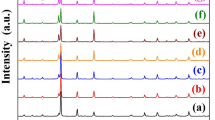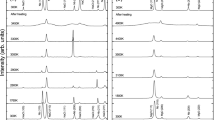Abstract
The Curie point, that is, the transition temperature between the ferro-electric and the non-ferro-electric structures of barium metatitanate, BaTiO3, is characterized by a marked peak in the permittivity v. temperature curve and has recently received much attention, though reported values1–4 for the temperatures of maximum permittivity show in some cases considerable discrepancies. This may be due to the effect of impurities or the firing conditions employed. It has also been reported5 that there is a second-order phase transition from a tetragonal structure to a cubic structure at about 120° C. The identity of the temperature of this transition with that of the permittivity peak has been regarded as uncertain, and we have, therefore, determined the Curie point by two non-electrical methods, namely, X-ray structure determinations and specific heat measurements, and compared these with the permittivity using a material containing more than 99 per cent BaTiO3. That these effects occur at the same temperature has now been established, but a further complexity has, been revealed on detailed examination of the tetragonal to cubic transition.
This is a preview of subscription content, access via your institution
Access options
Subscribe to this journal
Receive 51 print issues and online access
$199.00 per year
only $3.90 per issue
Buy this article
- Purchase on Springer Link
- Instant access to full article PDF
Prices may be subject to local taxes which are calculated during checkout
Similar content being viewed by others

References
Rushman and Strivens, Trans. Farad. Soc., A, 42, 231 (1946).
Coursey and Brand, Nature, 157, 297 (1946).
Wul, J. Phys. (U.S.S.R.), 10, 64 (1946).
Jackson and Reddish, Nature, 156, 717 (1945).
Megaw, Proc. Phys. Soc., 58, 133 (1946).
Rusterholz, Helv. Phys. Acta, 7, 643 (1935).
van Santen and Jonker, Nature, 159, 333 (1947).
Author information
Authors and Affiliations
Rights and permissions
About this article
Cite this article
HARWOOD, M., POPPER, P. & RUSHMAN, D. Curie Point of Barium Titanate. Nature 160, 58–59 (1947). https://doi.org/10.1038/160058a0
Issue Date:
DOI: https://doi.org/10.1038/160058a0
This article is cited by
-
BaTiO3-based nanogenerators: fundamentals and current status
Journal of Electroceramics (2022)
-
Spectral weight reduction of two-dimensional electron gases at oxide surfaces across the ferroelectric transition
Scientific Reports (2020)
-
Strain engineering of piezoelectric properties of strontium titanate thin films
Journal of Materials Science (2014)
-
Anomalous Temperature Coefficient of Permittivity in Barium Titanate
Nature (1954)
-
Physical Properties of Substances of High Permittivity
Nature (1948)
Comments
By submitting a comment you agree to abide by our Terms and Community Guidelines. If you find something abusive or that does not comply with our terms or guidelines please flag it as inappropriate.


